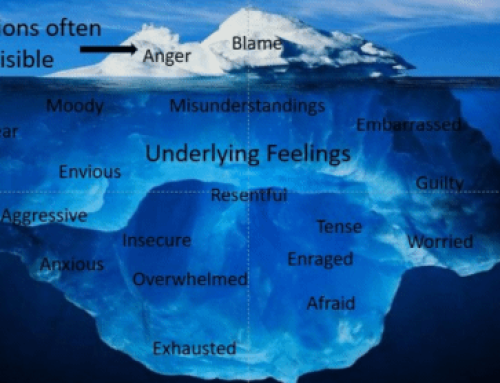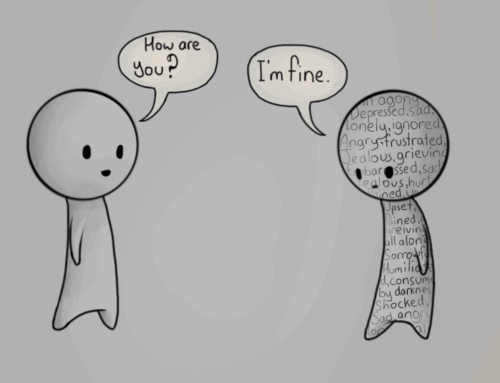Thoughts, Feelings, and Behaviors: It’s All Connected
August 23, 2015
Categories: Emotion
This post is Part 1 in a 4-part blog series on changing thoughts, feelings, and behaviors.
One popular kind of counseling is called cognitive-behavioral therapy (CBT). It’s based on the idea that our thoughts, feelings, and behaviors are all connected and influence one another. For example, if we are feeling sad or depressed, we might have thoughts like we aren’t worth much of anything, and we might do behaviors like stay in bed all day. On the other hand, if we are feeling happy or excited, we might have thoughts like the future is bright, and we might do behaviors like call a friend or go see a movie.
Track Your Thoughts, Feelings, and Behaviors
Sometimes it can be helpful to keep track of our thoughts, feelings, and behaviors, especially if we are feeling down and want to feel happier. Sometimes when I’m feeling down, I might not have an explanation for it. That happened to me a couple weeks ago. I was feeling sad, but I wasn’t sure why.
If we can pause and identify our thoughts, feelings, and behaviors, we might learn important information that could help us moving forward. For example, some of the thoughts I experienced that went along with my feeling sad were thinking that I was alone and out of step with most of my friends (most of whom are married and have their own families). The behaviors that went along with my feeling sad were staying in my apartment, not initiating with my friends, and not picking up the phone when someone called me.
Example of Tracking
So if I were keeping track of my thoughts, feelings, and behaviors, I might write down the following:
Time: Saturday night
Thought: I’m alone. I’m out of step with my friends.
Feeling: Sadness
Behavior: Isolating. Not calling friends. Not picking up the phone.
As I continue to track my thoughts, feelings, and behaviors, I can begin to get more information about what thoughts and behaviors are associated with each of my feelings. What’s going on when I’m feeling Sad? Angry? Scared? Happy? Excited? Tender?
Getting this information is the first step toward making a change.
Action Step: Stop three times during your day today and write down your thought, feeling, and behavior. Try to do this once in the morning, once in the afternoon, and once in the evening. Did you learn anything about yourself? What thoughts and behaviors are associated with each of your feelings?
Related Thoughts
24 Comments
Leave A Comment

Subscribe To My Newsletter
Join my mailing list to receive the latest blog posts.
Receive my e-book “The Mental Health Toolkit” for free when you subscribe.






I agree with what you presented in general but the most important part of the process was omitted — that is the part that the “heart” plays in producing the thoughts. Matthew 15:19 For out of the heart proceed evil thoughts, murders, adulteries, fornications, thefts, false witness, blasphemies:
Dixon, I too am a Christian. I asked a good friend of mine, dedicated Christian and outstanding clinical psychologist what the heart was referring to in scripture and he felt it was the origin of our thoughts. I have scriptures which support that but I am at work and don’t have them with me. However they are in Wrights book, How to Think.
[…] This post is Part 2 in a 4-part blog series on changing our thoughts, feelings, and behaviors. (If you missed the previous post, you can find Part 1 here.) […]
[…] This post is Part 3 in a 4-part blog series on changing our thoughts, feelings, and behaviors. (If you missed the previous posts, you can find Part 1 here.) […]
Interesting thought Dixon. I have some thoughts, but I want to preface this by admitting that I’m not a theologian, I haven’t studied this passage in its original language, etc. But my sense of this passage is that when Jesus talks about the ‘heart’ he is referring to what is on the inside of us (which from a psychological perspective could include thoughts, feelings, behavioral intentions, etc.). So my sense is that he uses the word ‘heart’ more broadly here, not just to refer to feelings or emotions. The reason I think this is the context of the passage seems to be about Jesus confronting the Pharisees, who are focused on the outside (e.g., hand-washing, etc.) but not the inside (e.g., motivations, love, justice, etc.).
That said, I do think that feelings can influence our thoughts and behaviors, although as someone who was trained in CBT, I generally think about the causal direction the other way (i.e., thoughts and behaviors leading to feelings). But that’s definitely not the only way to think about it.
[…] This post is Part 4 in a 4-part blog series on changing our thoughts, feelings, and behaviors. (If you missed the previous posts, you can find Part 1 here.) […]
[…] quickly. Press the pause button and sit with your feelings for a bit. What is coming up for you? What are your thoughts? What are your feelings (e.g., sad, angry, scared, happy, excited, tender)? Does anything about what […]
[…] and communities. In our personal lives, some of our most persistent problems occur because of problematic beliefs and thoughts. For example, we might feel depressed and think we are not worthy of love, perhaps based on a […]
I have checked your blog and i have found some duplicate content, that’s why you don’t rank high in google, but there is a tool that can help
you to create 100% unique articles, search for: Boorfe’s tips
unlimited content
Nice
[…] ACT is one of the third-wave behavior therapies, so it is a bit different from traditional behavior therapy. The first wave of behavior therapies focused on the theory of behaviorism, and used principles such as reinforcement, reward, and punishment to change behavior. The second wave of behavior therapies focused on cognitive-behavioral therapies (CBT), which targeted both overt behavior as well as one’s thoughts, which were thought to undergird one’s feelings and behaviors. […]
[…] change or improve something about your life, the key is to actually do something different. You can reflect on your thoughts and feelings all day long, but until you actually change something in your actual behavior, you are likely to […]
[…] This post is Part 4 in a 4-part blog series on changing our thoughts, feelings, and behaviors. (If you missed the previous posts, you can find Part 1 here.) […]
I have noticed you don’t monetize your blog, don’t waste your traffic, you
can earn extra bucks every month. You can use the best
adsense alternative for any type of website (they approve all websites), for more details simply search in gooogle:
boorfe’s tips monetize your website
Great information. Lucky me I found your blog by chance (stumbleupon).
I’ve book-marked it for later!
Triangle is true and present ,but there is no role of heart in the triange, heart pump out the blood only.
[…] is a difficult problem to solve. All our experiences are mediated by our thoughts and reactions. We don’t ever see our situation in a completely objective manner. Because of this, it’s […]
Thanks in support of sharing such a pleasant thought, post is
good, thats why i have read it fully
[…] trying to live a good life and have a positive attitude, we often reflect on our thoughts, feelings, and behaviors. All three are important and have a huge impact on how we engage in our day-to-day […]
[…] Mindfulness is a practice that focuses our attention on the present moment. We check in with our thoughts, feelings, and bodily sensations and just notice them in a non-judgmental way. One quick way to practice mindfulness is to focus on […]
[…] or bad—it just is. But we tell ourselves a story about how the rain is good or bad, and then we feel a particular emotion based on that story (e.g., happy, relieved, angry, frustrated, […]
[…] is a lesson here that can be helpful in our lives. When something goes wrong, we can have a lot of thoughts and feelings about the situation. We can get upset, frustrated, and angry with ourselves or the world. We tend […]
[…] humans, we have a tendency to get into patterns of thinking, feeling, and behaving. Some of these patterns are necessary and good. For example, pretty much every day I get up, have a […]
[…] cognitive behavioral therapy (CBT), a lot of emphasis is placed on the connection between problematic thoughts, emotions, and behaviors. Problematic thoughts are seen as “causing” problematic emotions and behaviors. If you can […]